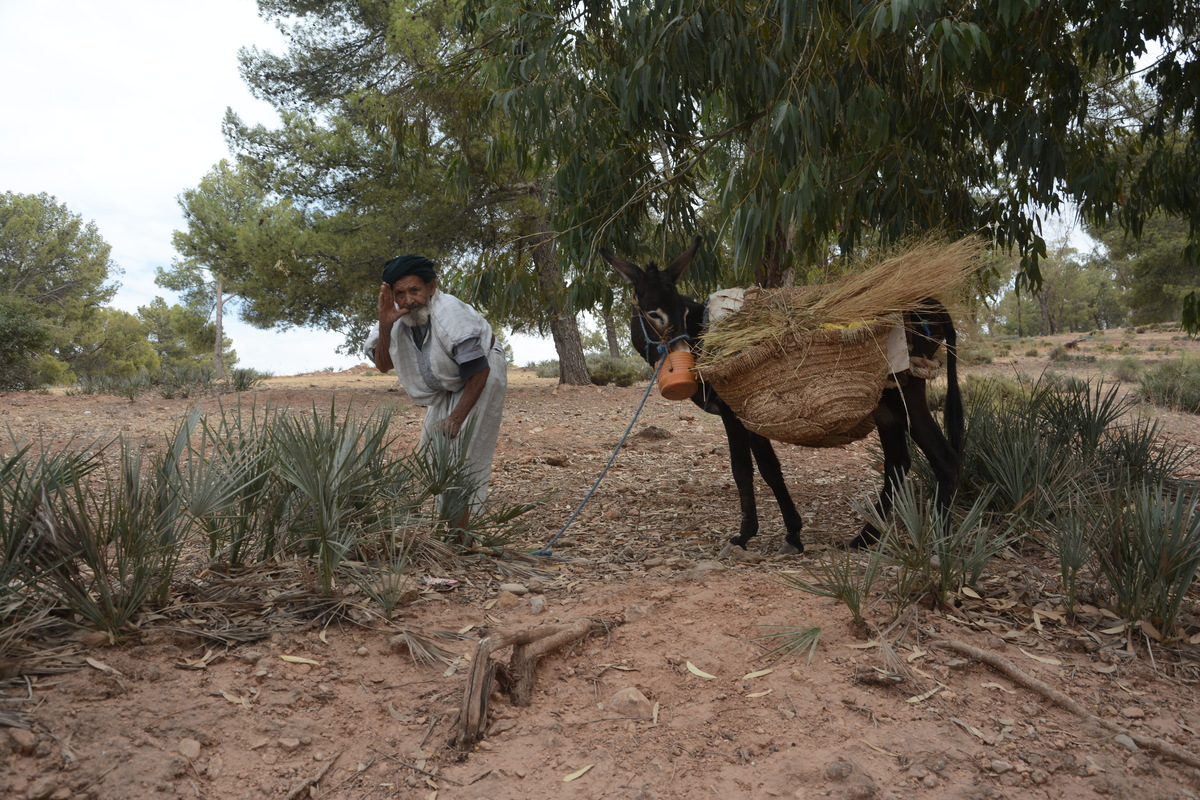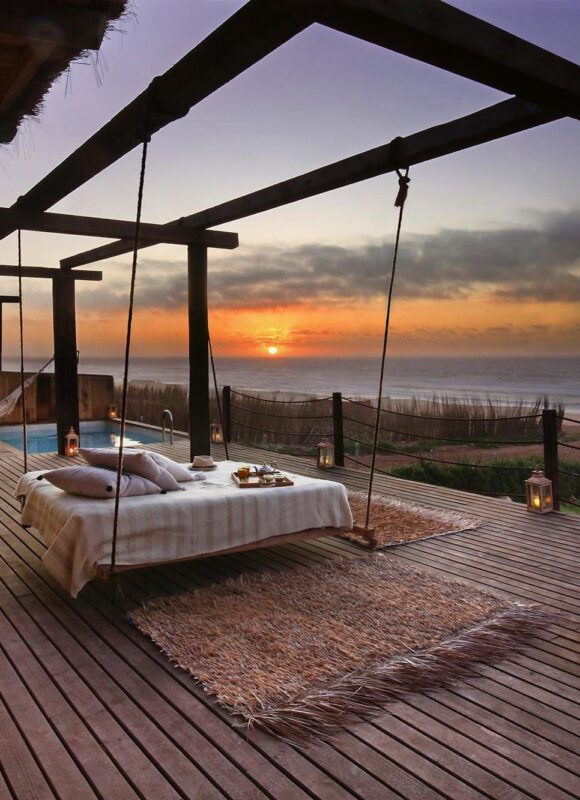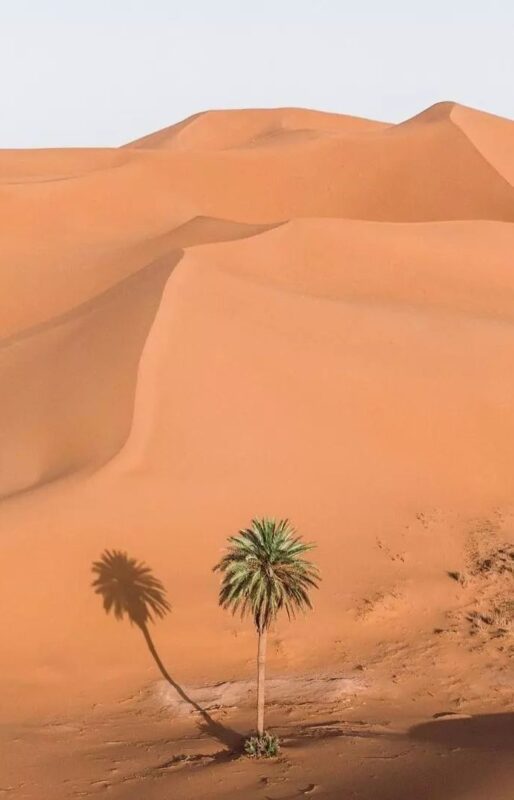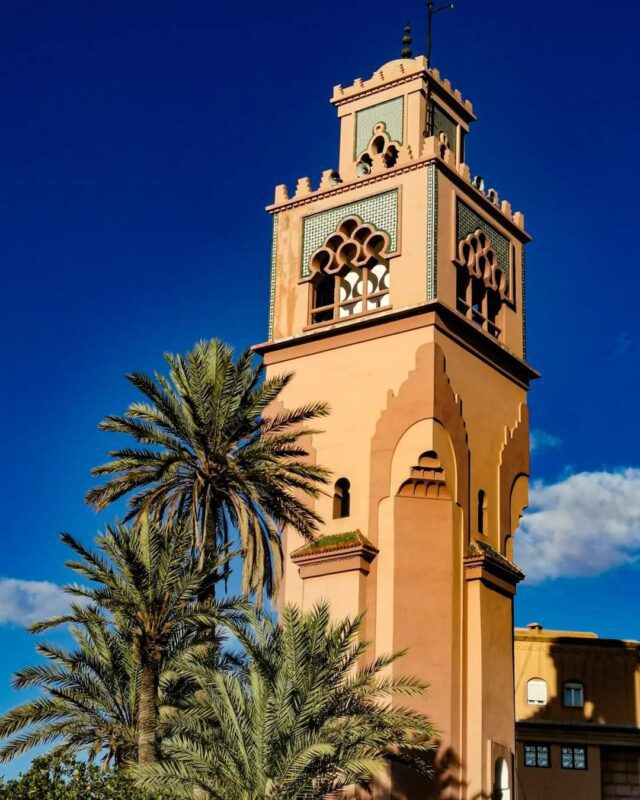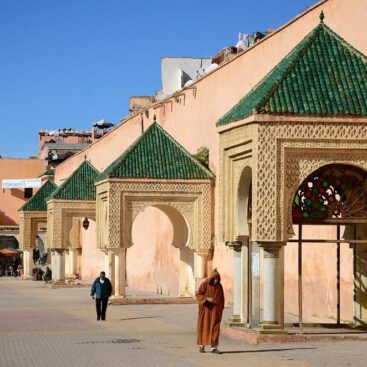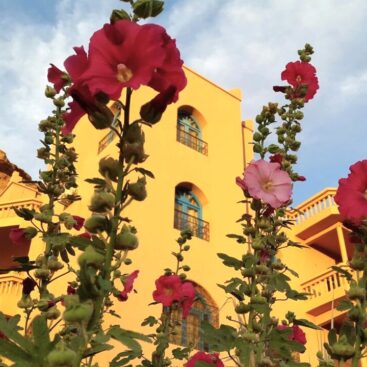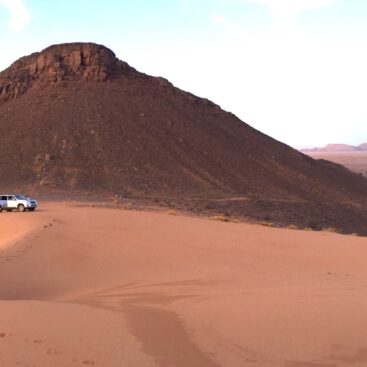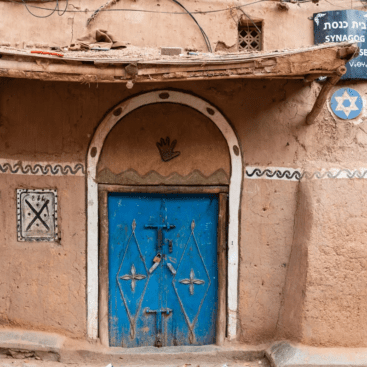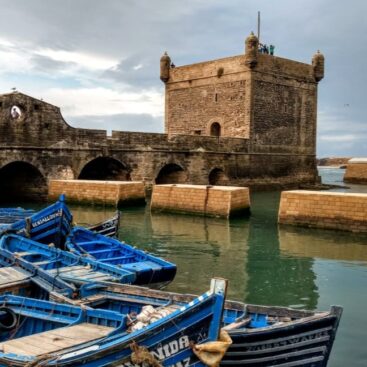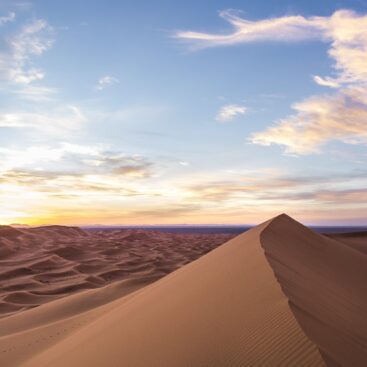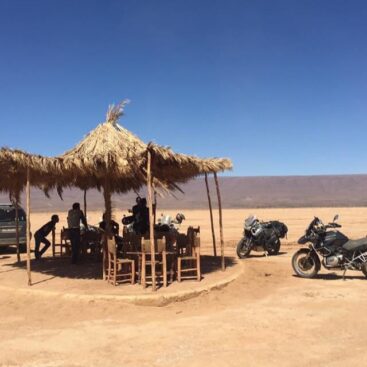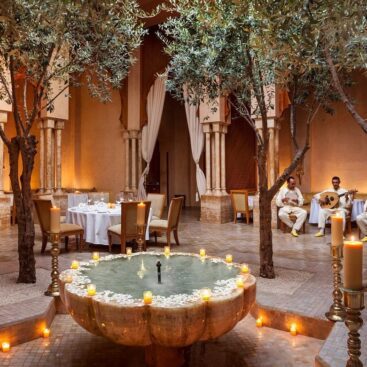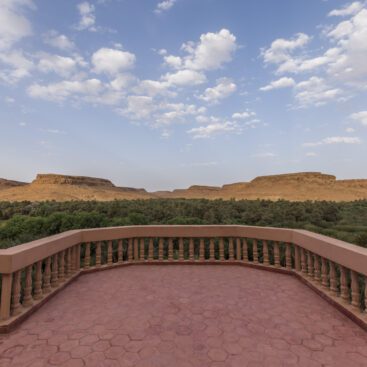Morocco offers an impressive diversity of landscapes, traditions, nature, and culture. By exploring the country in depth, you will come into contact with its 5 elements: deserts, mountains, beaches, oases, and vibrant cities.
Throughout the trip, you will experience the scorching silence of the desert and the hypnotic magic of the oases, as well as enjoy the beauty of the Atlantic coast, breathe the fresh mountain air, and discover the vibrant life of the Moroccan cities.
Casablanca and Rabat
In Casablanca, the main highlight is the majestic Hassan II Mosque, built over the sea. It is the only mosque in the country open to non-Muslim visitors. Impressive in its grandeur, it is the tallest mosque in the world outside of Mecca. During the guided tour, you will have the opportunity to explore this iconic and beautiful Moroccan landmark in detail.
In addition, you can also explore the Our Lady of Lourdes Cathedral, built by the French in 1954, whose stunning stained glass windows will captivate you.
Then, we head to Rabat (a trip of just one hour), where you can admire the beautiful domes, minarets, wide avenues, and generous green spaces.
Rabat
Rabat is a city that flourished in the 14th and 15th centuries following the expulsion of the Andalusians from the Iberian Peninsula. Surrounded by three walls that reflect the most significant phases of its history — the Almohad, Andalusian, and Alawite walls — the city is rich in heritage and architecture. During the tour, your guide will lead you along the walls and to the city’s main attractions, such as the iconic Hassan Tower, situated atop an imposing mosque, the opulent Mausoleum of Mohammed V, and other historical monuments.
Chefchaouen, the Blue Pearl of Morocco
Getting to Chefchaouen is like entering a labyrinth of charming streets that set it apart from other Moroccan medinas, thanks to its unique order and organization. All roads lead to Hamman Square, home to the largest mosque and the main gathering place for the locals.
The imperial city of Meknes
Sultan Moulay Ismail dreamed of transforming Meknes into the most splendid city in North Africa. A contemporary of Louis XIV of France, Moulay Ismail maintained relations with the French king and, inspired by the splendor of the European court, sought to imitate the style and grandeur of Versailles. As a result, he became a historical figure, even proposing marriage to the French king’s daughter. The city is even known as the “Versailles of the Maghreb.” During the visit, with the help of our guide, you will be able to explore the most emblematic places of Meknes. Additionally, the region is famous for its wine production, especially from French grape varieties, highly appreciated for their quality.
Roman ruins of Volubilis
Next, we continue to the ruins of Volubilis, an exceptionally well-preserved example of an ancient Roman colonial city. Volubilis, which marked the southern border of the empire, was the main Roman administrative center in Africa, outside of Egypt. Here, you will take a guided tour of the area and learn more about the rich history and architectural legacy of this impressive archaeological site.
In the late afternoon, we will arrive in Fez, where you will still have time to enjoy the city at one of its most splendid moments, bathed in the soft light of sunset. Before ending the day, we will take a brief panoramic tour of the city.
Fez: an enchanted labyrinth sheltered from time
Fes was once the capital of Morocco and holds influences from the Fatimids, Andalusians, Arabs, Berbers, and Jews. The city reached its peak in the 13th century, when it became an important center of knowledge, housing one of the oldest universities in the world.
The Medina of Fes is the largest and most impressive of all the historic medinas in North Africa, with its labyrinthine and secretive streets, where traditional trade and tanneries thrive, and leather is still processed using ancient techniques. During your visit, explore the famous “Chouara” tannery, a landmark of the city.
You will also have the opportunity to visit several quranic schools, where you can admire some of the finest examples of Moroccan decorative delicacy.
Ifrane
During the journey, we will make a brief stop in Ifrane, a charming village located between the High Atlas and the Middle Atlas. This privileged location allows you to take in the lush mountain landscape. Along the way, you might spot monkeys and other animals typical of these cedar forests.
Erfoud
On the way, we will also pass through Erfoud. Nearby, there are excavation sites where various trilobite fossils, among other primitive species, have been found. These discoveries confirm that, in ancient times, the soil of the Sahara Desert was once the bottom of an ocean. Here, you will have the opportunity to admire a fossil exhibition.
Sahara Desert (Merzouga)
During the day, you can embark on various desert adventures, from thrilling quad bike rides on the dunes to participating in Moroccan cooking workshops. You can also engage with the nomads, immersing yourself in their music and traditions for a truly unique cultural experience.
Khamlia and Rissani
The next stop will be the refuge of the nomadic peoples of Khamlia, a remote village home to the Gnawa people, originally brought from Sudan as slaves. In this isolated village, you can enjoy their vibrant music, lifestyle, culture, and traditions, discovering an authentic and profound side of life in the heart of the Sahara..
After this experience, you will also have the opportunity to have lunch with a local family and share in their customs.
Next, we head to Rissani, a city that was once the capital of Morocco. Here, you’ll find a famous “souk,” where you can purchase a variety of local handicrafts at affordable prices. Largely untouched by mass tourism, this place retains its authenticity. Take the opportunity to try the traditional Berber pizza, still prepared using ancestral methods.
Sahara Dunes (Erg Chebbi)
In the late afternoon, embark on a camel ride through the Erg Chebbi dunes, a journey of about an hour, leading to the Berber tent where you will spend the night. The colors of the sunset over the dunes are a true delight for photography enthusiasts, offering a sublime visual spectacle.
In the evening, dinner will be served, followed by a live traditional music performance around a campfire. The combination of drums and guitars creates an irresistible and immersive atmosphere. Finally, the moment arrives for the stunning and magical absolute silence of the desert, inviting introspection. Under a clear sky filled with stars, you will undoubtedly experience an unforgettable moment.
During the journey, we will visit the Todra Gorges, where the stunning cliffs rise to 300 meters in height, separated by a mere 15 meters. There will be time to enjoy a walk along the river, surrounded by the grandeur of this unique, rocky landscape.
Dades Valley, a place of stunning beauty and geological interest
This valley offers a diverse range of landscapes, from arid mountains resembling those of the desert to a fertile valley where the sounds and scents of nature can be heard and felt. It also features mountains where, in winter, snow can be seen, along with various typical Kasbahs—ancient walled villages. Additionally, you will have the chance to see Jbel Saghro, a mountain even more barren than the others in the range, with a landscape often compared to the surface of the Moon.
Our journey continues along the high mountain roads of the High Atlas. Take the opportunity to take photos while enjoying the fresh air and serenity of this majestic mountainous region.
Ouarzazate and Ait Benhaddou
Ouarzazate is known as the city of the “Doors of the Desert,” due to its strategic location between the Atlas Mountains and the Sahara Desert. In this city, you can visit the Taouirt Kasbah, an ancient fortress that houses the palace of Pasha Glaoui, located near the Medina. Additionally, be sure to explore the renowned film studios (Atlas Studios), where several historical films were shot, including the iconic Lawrence of Arabia.
Soon after, we will make a stop at Ait Benhaddou, a site of great importance along the “Route of a Thousand Kasbahs“, which has been designated a UNESCO World Heritage site. This location is particularly famous for having served as the backdrop for many Hollywood films, such as The Mummy, Gladiator, and Game of Thrones.
On the way to Imlil, if you’re interested, we can make a few stops, such as visiting craft cooperatives to observe the traditional handmade production of famous Moroccan carpets, as well as learning about the process of making argan oil and other local products.
Imlil
Imlil is a typical Atlas village, situated at an altitude of 1,760 meters. Here, you can appreciate the beauty, tranquility, and grandeur of the mountains. Located near Marrakech, Imlil is the ideal destination for those who enjoy outdoor activities and hiking, whether on foot or by mule, through the mountains. Among the peaks surrounding the village, Toubkal stands out as the highest point in North Africa, reaching 4,167 meters in altitude.
In addition, there are several fascinating landscapes that can be visited from Imlil. These include Lake Takerkoust, small Berber Atlas villages, and locations where traditional Moroccan carpets are handmade.
Since the time when Carthage was an empire, this coastal area has always been considered one of the best anchorage spots in the North African Atlantic. Its medina, built in the 18th century, is one of the few in the world that actually had architectural planning. It was during this time that the city was named Essaouira, which literally means “the beautifully designed.” Additionally, the city is home to the famous Gnawa Music Festival, an ancient spiritual art of North African Islam. Its medina is a UNESCO World Heritage Site.
In the afternoon, we will head to Marrakech, an imperial city with a vibrant and dynamic atmosphere.
Among the must-see monuments to visit, the highlights include:
Madrassa Ben Youssef: This Islamic college, built in the 12th century by order of Sultan Ali Ibn Yusuf of Morocco, now functions as a museum. The interiors are beautifully decorated, and the architecture is stunning.
Koutoubia Mosque: Without a doubt, this is the most famous and photographed monument in Marrakech. The Koutoubia Mosque was built in the 12th century and served as a model for the Giralda in Seville and the Hassan Tower in Rabat, reflecting the grandeur of Islamic architecture.
Bahia Palace: This beautiful and extravagant 19th-century palace was built to be the finest in Marrakech. It features a vast garden, a central courtyard, and several rooms decorated with craftsmanship from artisans who came specifically from the city of Fez to work here.
Saadian Tombs: Commissioned by Ahmad al-Mansur in the 16th century, these tombs and mausoleum house the bodies of around 60 members of the Saadian Dynasty, which originated from the Draa River valley in the south of the country. Interestingly, the tombs were only discovered in 1917. Today, they are one of the most visited monuments in Marrakech.
Palais Dar Bacha (or Musée de Confluences): This wonderful example of Arab architecture features a very special café, where you can enjoy coffees from around the world in a cozy atmosphere.
Jma el Fna Square, the most lively area of the city, classified as Intangible Cultural Heritage by UNESCO. Here, you will find various exotic performances, snake charmers, storytellers, musicians, handicrafts, and many food stalls offering traditional street food, showcasing the best specialties of the country.
Visits to Marrakech outside the Medina with our guide, including the following locations:
Majorelle Gardens: This is the only botanical garden in Marrakech. Designed by the artist Jacques Majorelle and owned by Yves Saint Laurent and Pierre Bergé since 1980, the garden offers a charming experience with exotic flowers from various parts of the world.
Yves Saint Laurent Museum: The museum features a permanent exhibition, as well as temporary exhibitions, showcasing the masterpieces of this famous designer. The building blends modern architecture with traditional touches, creating a culturally rich atmosphere.
La Menara: Located just 2 km from Jemaa el-Fna Square, this garden is a favorite spot for the Marrakchis (the residents of Marrakech) for a relaxing Sunday afternoon walk. The gardens were originally built in the 12th century, but the current structure dates back to the 16th century.
The modern Gueliz neighborhood: This area stands out for its architecture, which is well integrated into the spirit of the city, harmoniously blending with a contemporary vision.
- Arrival and departure transfers to the airport;
- Private transportation throughout the trip in a new and safe minivan with air conditioning. All of our vehicles are licensed by the Moroccan government for tourism and have insurance for our clients;
- A permanent guide who speaks English;
- Accommodation throughout the trip, including breakfast;
- Dinners on the 2 nights in Merzouga and the Dades Valley;
- Additional official guide in the cities of Marrakech, Meknes, and Fez;
- 1 night in a Berber camp in a luxury nomadic tent;
- Camel ride with a view on the way to the camp.
● Drinks and other meals (lunches and snacks);
● Entry fees to monuments.
Highlights of the Trip
- Night in the Sahara Desert dunes
- The green hues of the oasis and the blues of Chefchaouen
- High Atlas Mountains (Imlil)
- Essaouira (beach)
- Imperial cities of Marrakech, Fez, Meknes, and Rabat
- Nature and Culture
Activities of Your Choice
- Hikes in the Atlas Mountains
- Sandboarding (snowboarding on the desert dunes)
- History and storytelling
- Craft tour
- Yoga in the desert
- Surf
- Other activities

